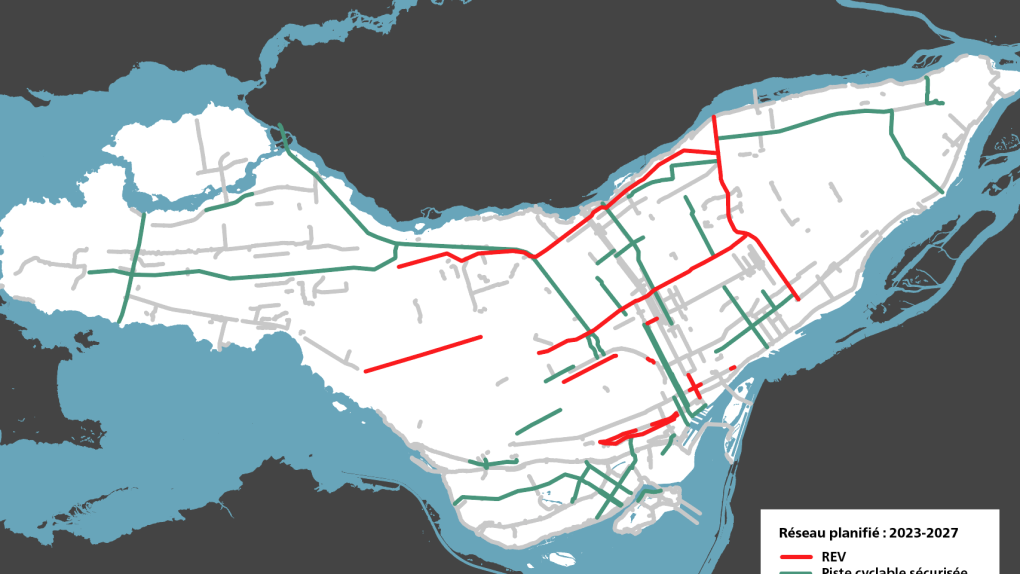Montreal unveils plan to expand bike path network over 5 years
The City of Montreal revealed a plan to expand the cycling network over the next five years, especially in neighbourhoods that don’t have already existing infrastructure.
It’s something cycling advocates in Montreal North have been asking for and say it will be a game changer.
They say the bike path set to be created on Maurice Duplessis Boulevard will give close to 10,000 students the option to bike to school safely, and allow residents to get around easier.
 Map of Montreal's bike infrastructure plans
Map of Montreal's bike infrastructure plans
"I can finally go to my parents' house with my kids on a bike," said Jean-François Gange, a spokesperson for Montreal North Secure Mobility Association.
“I live and work in Montreal North. It can take me 25 minutes on bus but if I take my bike, it's just eight minutes. It’s a big difference and I save money because I don’t take the bus,” said Fatima Gabriela Salazar Gomez, also a member of the association.
Following a recommendation from public health, the city's plan promises 200 kilometres of safe bike paths in the next five years.
- Development of the Jean-Talon REV
- Development of the Henri-Bourassa REV
- Development of the Lacordaire REV
- Upgrading and extending the Côte-Sainte-Catherine bike path, to make the intersection of the Park and Mont-Royal safer
- Redevelopment of the de la Commune bike path between Berri and Saint-Laurent
- Creation of a bike path on Hochelaga Street, to link Mercier-Hochelaga-Maisonneuve and Ville-Marie
- Addition of bicycle paths on Prieur and Charleroi, which will link Ahuntsic-Cartierville and Montreal North
- Development, in the West Island, of the Sainte-Anne-de-Bellevue branch and the Deux-Montagnes branch of the bicycle route, along the western REM line.
"In this announcement we see things in Montreal North, Saint-Michel, ParkEx, Côte-Des-Neiges—NDG, the fact to create a bicycle network all across the city is really important to make sure everyone has the option to choose to ride a bike,” said Jean-François Rheault, president and director-general of Vélo Québec.
Once a dreaded construction site, the bike path along St-Denis is now the inspiration for other commercial destinations.
According to Jacques Nacuzi, a member of the St-Denis merchants' association, the storefronts on the street are 83 per cent occupied, the highest percentage since 2015.
It has a designated bike lane, reserved parking spots for deliveries, and crosswalks.
"The bike path has two effects: one that is direct — you bring more customers. And one that is indirect that makes the road calmer and more environmentally friendly," said Nacuzi, who also co-owns the Code & Café store on St-Denis.
The city said when it comes to how the plan will affect parking, it will work with each area to determine its needs.
"Every project is going to be unique, every project is going to be thought about very closely with its environment," said Marianne Giguère, a city councillor for the Plateau-Mont-Royal borough and adviser on active transport.
The opposition at City Hall thinks the plan is a good one, highlighting the path along the REM de l’Ouest — a request made by Pierrefonds-Roxboro and Saint-Laurent for several years.
The city plans to add 40 kilometres of bike lanes per year for the next five years at a cost of $30 million dollars per year.
- Listen on CJAD 800: IN TRANSIT: How Montreal is becoming a haven for cyclists
CTVNews.ca Top Stories

Bird flu, measles top 2025 concerns for Canada's chief public health officer
As we enter 2025, Dr. Theresa Tam has her eye on H5N1 bird flu, an emerging virus that had its first human case in Canada this year.
Azerbaijan observes day of mourning for air crash victims as speculation mount about its cause
Azerbaijan on Thursday observed a nationwide day of mourning for the victims of the plane crash that killed 38 people and left all 29 survivors injured as speculation mounted about a possible cause of the disaster that remained unknown.
Donald Trump says he urged Wayne Gretzky to run for prime minister in Christmas visit
U.S. president-elect Donald Trump says he told Canadian hockey legend Wayne Gretzky he should run for prime minister during a Christmas visit but adds that the athlete declined interest in politics.
Working Well: Returning to the office can disrupt life. Here are some tips to navigate the changes
Heading into 2025, thousands of workers face an unsettling reality: after years of working from the comfort of home, they must return to the office full-time for the first time since the coronavirus pandemic or look for new work.
Prayers and tears mark 20 years since the Indian Ocean tsunami that killed some 230,000 people
People gathered in prayer and visited mass graves in Indonesia’s Aceh province on Thursday to mark 20 years since the massive Indian Ocean tsunami hit the region in one of modern history’s worst natural disasters.
New York taxi driver hits 6 pedestrians, 3 taken to hospital, police say
A taxicab hit six pedestrians in midtown Manhattan on Wednesday, police said, with three people — including a 9-year-old boy — transported to hospitals for their injuries.
Historical mysteries solved by science in 2024
This year, scientists were able to pull back the curtain on mysteries surrounding figures across history, both known and unknown, to reveal more about their unique stories.
Thousands without power on Christmas as winds, rain continue in B.C. coastal areas
Thousands of people in British Columbia are without power on Christmas Day as ongoing rainfall and strong winds collapse power lines, disrupt travel and toss around holiday decorations.
Ho! Ho! HOLY that's cold! Montreal boogie boarder in Santa suit hits St. Lawrence waters
Montreal body surfer Carlos Hebert-Plante boogie boards all year round, and donned a Santa Claus suit to hit the water on Christmas Day in -14 degree Celsius weather.

































